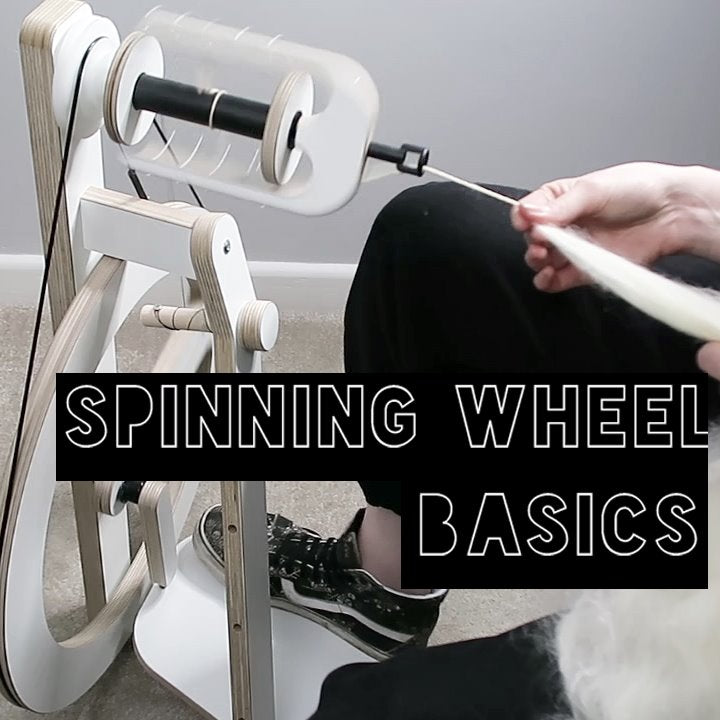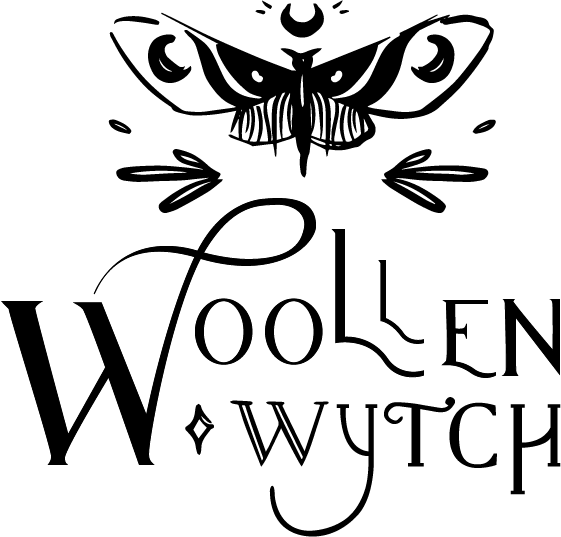
Spinning Wheel Basics
Share

There are so many different types of spinning wheels on the market, and they all do the same job, but slightly differently. Buying your first wheel can feel completely daunting and confusing. Don't worry, pretty much everyone feels the same. And you'll find almost everyone owns more than one, simply because they're not completely sure which one to settle on.
Buying your first beginner spinning wheel when you've never even used one before can be such a surreal feeling. Ploughing that kind of money into equipment you've never touched let alone understand how it works is scary. AF.
But fear not, I'm going to walk you through the most very basic of how a spinning wheel works and what the parts are and do. I'll also go into a little bit more detail on a few things to help you make a more informed choice on wheels.
For diagram and information purposes I'm using photographs of my Woolmaker's Bliss spinning wheel, and my DIY Spinning wheel.

To cover the very very basics of how a Spinning wheel works, I filmed the little video at the bottom of the page for those that like to jump straight in and skip the writing. So scroll down to watch it.
Foot Treadle - One or Two Feet
Similar to older Sewing Machines, spinning wheels are run via a foot treadle. The treadle is basically a pedal you push with your feet to move the wheel around. The fast you push the pedal, the faster the wheel turns. Some wheels have two treadles, others just the one, it doesn't make too much difference to your spinning and is more personal preference than anything.
Wheels & Drive bands.
The large wheel is called the drive wheel or flywheel and is the powerhouse of the spinning wheel. Connected to the treadle by the footman, on the bliss the footman is a small rubber rod connect from wheel to treadle, which causes it to spin when you step on the treadle.
The drive wheel is then connected to the flyer or bobbin by the drive band. The drive band is a looped band made out of rubber, cotton, hemp or stretchy nylon material that loops around the wheel and then around either the flyer or bobbin, depending on the drive system of the spinning wheel.
Mother of All
The Mother of All is where all the fiddly bits live and is pretty much the business end of the spinning wheel. It houses the flyer, bobbin, tension cords and brake system. It's usually nothing more than a simple bar, but it is an important part that holds everything.
On the Bliss spinning wheel the flyer is attached to the bobbin via a magnet and so doesn't need a mother-of-all for support.
Orifice
The orifice is a hole on one end of the flyer you feed you yarn and fibre through as you spin, in order to add twist and feed onto the bobbin.
The bigger the Orifice, the chunkier the yarn you can spin.
Flyers & Bobbins Oh My!
The flyer is a U-shaped piece with a metal shaft through the middle to hold the bobbins in place and allow them to spin. The arms of the flyer, the U bits, usually have hooks to allow the yarn to wind onto the bobbin evenly, either at fixed distances or as a sliding guide.

The bobbin is basically a spool and slips on to the flyer. As you spin yarn, it will be pulled through the orifice onto the hooks on the flyer and wrapped around the bobbin all automatically as you spin.
Most spinners to make life easier, tie a leader yarn to the bobbin when they begin spinning wool. The leader yarn is tied to the bobbin, threaded through the flyer hooks and then the orifice. As the wheel spins, twist builds upon the leader yarn and begins pulling in the wool or other fibres. Bliss spinning wheel bobbins have a handy little notch on the bobbin to attach the leader without faff.
While technically you only need one bobbin, most spinners like to have at least three bobbins in their arsenal. This makes it easier to ply your yarn singles together, especially if you have a lazy kate, Bliss wheels actually have one built directly on the wheel- not extra equipment needed.

Bobbin sizes and shapes differ from wheel to wheel. Some models have multiple sizes of bobbin available for different purposes, such as a larger bobbin for plying or creating very bulky yarns. Probably the largest bobbin you'll come across is the Ashford Country spinner which is massive for Art yarn spinning, which the wheel is specially built for.
Feelin' the Tension
In amongst picking a type of flyer and bobbin size, you also have your tension to think about, this is probably one of the more confusing factors to think about when purchasing a wheel. The main types of tension available on Spinning wheels are: Irish tension; scotch tension; and double drive.
Scotch tension and double-drive wheels have a whorl on the flyer where the drive band sits. These whorls may be up front, close to the orifice, or a separate piece that attaches to the back of the bobbin shaft. On a bobbin-lead wheel, this whorl is located right on the bobbin. Most wheels have at least two different sizes of whorl, which determine how many times the flyer spins for each full rotation of the drive wheel. A smaller whorl will rotate more quickly, pushing twist into the fibre at a faster rate.
Scotch Tension

Scotch tension is generally found on flyer-lead wheels, where the drive band loops around a pulley on the flyer, the bobbin spins independently from this and is held in place by a separate brake band attached to a tensioning knob. When the flyer spins faster than the bobbin, yarn to able to be pulled through the flyer hooks and wound on to the bobbin.The brake band needs a bit of elasticity or give to it, which can come in the form of a metal spring or rubber band attached to a non-elastic string. Since the drive band and brake band work separately, it’s easy to fine-tune your wheel depending on the type of yarn you want to spin.
This type of tension or brake system is very common and easy to adjust for different styles of yarn.
Irish Tension

On a bobbin-lead wheels, similar to my DIY wheel, the drive band is held right on the bobbin, you can usually tell because the bobbin will have different whorl sizes for the drive band to sit around. The brake band is located on the flyer, near the orifice. In this type of system, the flyer slows down and the bobbin continues to turn, to wind on the yarn.
This system is ideal for larger, heavier yarns such as Art yarn spinning because of the stronger intake of the yarn.
Double Drive
Double-drive spinning wheels aren't as popular or as widely available as the other types of spinning wheel tension, but are common on older wheels. The drive band is a long band that is folded and goes around the drive wheel twice. One loop sits around the flyer whorl and one around the bobbin whorl, and both are connected to the drive wheel. In this system, the small bobbin whorl turns faster than the flyer whorl, pulling the yarn onto the bobbin.
To be honest a small paragraph on each tension isn't enough- I will most definitely be covering Types of Spinning Wheel Tension more in-depth in another blog post.
How do they work together?
That is much easier to explain in video than writing, so press the play button below and watch how spinning wheels work.
There you have it! A little overview of the anatomy of a spinning wheel. Once you understand the parts of a spinning wheel, you will have a better understanding of how they work together smoothly for a great spinning experience.
Take care & Make good choices.
Stephanie
xx

